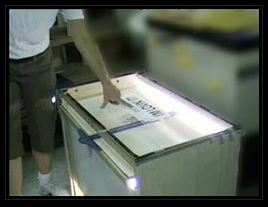Wednesday, December 4, 2019
What is screen printing?
There is a big, fancy definition that I can quote as to what screen printing is.... but the easiest way that I have heard the humans describe it, is a big stencil that you print on a garment, bag, or even a poster.
So there are a couple of basic supplies you need to get a screen created.
The first is a screen (duh) which has a fine mesh pulled tightly across the frame. This creates a blank screen.
The next is an image that you want to print. Each color has to be separated to just that part of the design. So the more colors the design, the more screens that you are going to need.
Now for a little more technical part....
To create the image on the screen... you coat the whole screen with a photo-sensitive emulsion.
It's kind of light coating the screen with a white glue type stuff.
Then comes the fun part, the light sensitive part.
You take the part of your design that you want to print, and block that part of the design (also called design masking) and then expose the whole thing to a UV light.
The UV light cures and hardens the emulsion. Then you wash the screen and wash away the part that was under the mask, leaving a stencil...
So now you have a completed screen. For a 1 color design. You just need to repeat the process for each color in your design, and you're almost there.
Now all you need to do is set the screen up in a screen printing press. This holds the screen steady, and the item you are printing steady so that the whole process is repeatable for as many items as you want to print.
A fancy multi-color screen printing press is shown here.
As you can see, each color of the design gets it's own screen and station on the press. The screens and the platens (the flat part where the shirt goes) both rotate.
Typically you will load, align and adjust all the screens so the image looks good and is aligned. Then you lock the screens down, so they all print the same location every time.
Then you load your shirts on the platens and make sure they are all straight and aligned.
Now you are ready to start printing!
Starting at your first print station (let call it the black screen in the above picture), you will print the black in the first shirt, and then rotate the shirts underneath to the next one and print the black on the second shirt... all the way around until they all have the black print on them. Then you can rotate the screens on top (thus time to the red screen) and print the red on all the shirts.
You can then continue on like this until you have all the colors you need to create the final design.
The actual printing is done by using a rubber edged paddle (think squege) to force the ink through the screen (stencil).
It looks something like this....
A: Ink color
B: Paddle (squege)
C: Design opening (after exposing and washing emulsion)
D: Light cured emulsion (doesn't wash away)
E: Screen and frame
F: Final design (ink is pressed through C)
So that in a rather long a somewhat complicated nut is how screen printing works.
As you can tell from the explanation, the more colors, the more complicated the process works.
Going from a 1 color design to a 2 color design doubles the amount of materials, set-up time, and printing time required.
You are also limited to the number of colors that the printing press has stations.
Okay, wow, that was a lot of typing... I think I have earned myself some crunchies and a little nap.
Until next time....
Subscribe to:
Comments (Atom)
What is screen printing?
There is a big, fancy definition that I can quote as to what screen printing is.... but the easiest way that I have heard the humans descri...

-
I have been able to piece together some of the history of Accurate Promotions after listening in on lots of conversations between Matt and t...
-
There is a big, fancy definition that I can quote as to what screen printing is.... but the easiest way that I have heard the humans descri...








